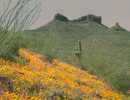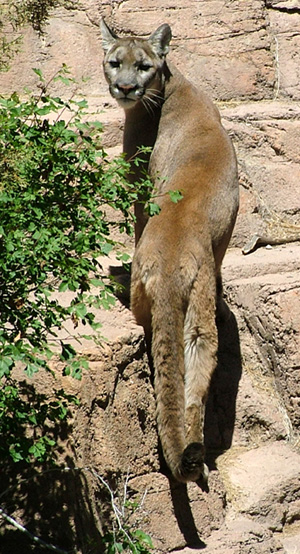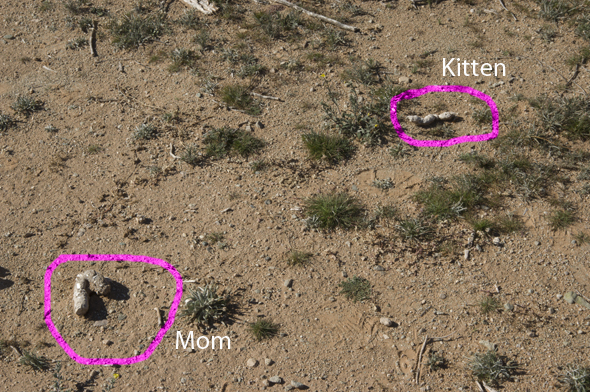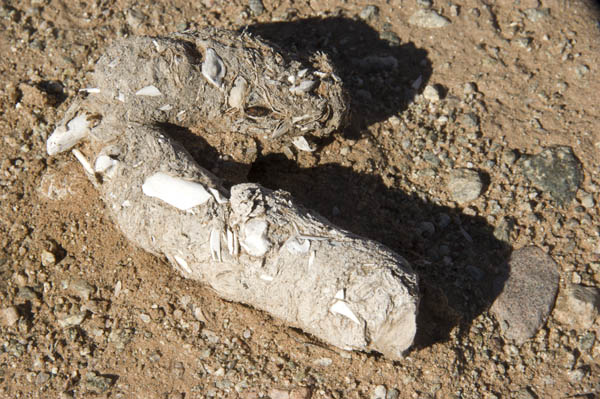
Cabeza Prieta Natural History Association
Sonoran Desert Mammals

Mountain lion
(Felis concolor)



|
Diet: carnivorous
Color: brown above with dark-tipped, long tail Size: female up to 75 lbs, male up to 145 lbs Active Period: active all times |
Throughout the world, the names cougar, mountain lion and puma refer to the same animal, Felis concolor which means "cat of one color". Other names are cuguacuarana (Brazil), Klandagi (Cherokee), Koe-Ishto (Chickasaw), painter, catamount, and many more.
There are 37 species of cats that exist today. They are generally divided into two genera; the large roaring cats, Panthera, and the smaller purring cats, Felis. The mountain lion is the largest of the purring cats. The ability to roar, which depends on the structure of the animal's hyoid bone, separates the African lion (Panthera leo), jaguar (panthera onca), leopard (Panthera pardus), and tiger (Pantheratigris) from the mountain lion.
The mountain lion (Felis concolor) is the largest North American cat, except for rare Southwestern sightings of the slightly larger jaguar (Panthera onca). Male and female mountain lions look alike; sides of muzzles and backs of ears are dark brown or black, while the chin, upper lip, chest and belly are creamy white. The rest of the body is pale brown, with a dark tip on the tail. Mountain lion tails are very long, almost two-thirds the length of the head and body. A typical male weighs 110-180 lbs. depending on geographical range, while the female is 80-130 lbs. "Males measure 6 to 8 feet from nose to tail tip and females 5-7 feet." Hansen, 1992.
Male pumas lead solitary lives, except when mating, while mature females are usually accompanied by cubs. Both sexes tend to space themselves out and confine their movements to individual home ranges. Such cats are called residents, and their home ranges can vary in size from 25 to 300 square miles, depending on quality of habitat and abundance of prey. Possession of a home range increases a resident's chance for survival by guaranteeing an established hunting ground. The larger home ranges of the male typically overlap or encompass several female ranges, but only occasionally overlap those of other resident males. However, female home ranges commonly overlap each other.
Male and female mountain lions are sexually mature at 24 months. When it is time to mate, the lions make up for long solitude with some of the most vigorous breeding behavior in the animal world. For a 7-8 day period, copulation can occur at a rate of 50-70 times per 24 hours!
Pregnant females do not prepare elaborate dens, only enough to protect the young ones from sun and rain and predators (golden eagles, coyotes, and other mountain lions). Newborn mountain lions enter the world after an 88-96 day gestation period weighing less than a pound. Litters average two or three cubs, which have coats covered with black and brown spots and rings around their tails. The cubs begin nursing minutes after birth. Within three weeks they weigh more than two pounds. After being weaned at two to three months, the young start to lose their spots and they accompany their mother to kills. At 17 months, their baby blue eyes have turned golden brown. At ages of 12-18 months, the young cats depart from their mother's home range and disperse to establish their own home ranges.
In the wild, mountain lions live for 8-10 years. A typical female may produce 5 litters in her lifetime.
Deer are at the top of the menu for the almost completely carnivorous mountain lions. Also included are elk, wild hogs (in Florida), rabbits, rodents, birds, livestock, and once in a while, a peccary or another mountain lion.
Reference:
"Cougar, The American Lion", 1992, by Kevin Hansen in association with The Mountain Lion Foundation, and with a forward by Robert Redford.
Photo Credits:
Photo #1
Photo #2
Photo #3
Copyright Creative Commons
HTML & Programing by
Thomas R. Powell